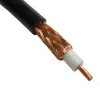
Belden 8402 microphone cable interconnects and Best-Tronics Pro Audio! - Jeff's Place
This post is a reminder to all of you - and to me - that you don't have to spend huge amounts of money to get high-performance interconnects. It's easy to spend many thousands of dollars for pairs of high-performance shielded RCA interconnects, and those spendy interconnects are a dime a dozen...
Earlier this month Jeff Day had blogged about his experience with Belden 8402 IC.
Towards the end of the article he mentioned about using the Belden 8402 digital coax cable.
I have been using my Belden 8402 as digital coax from my Mutec to my DAC over the past couple of days and the sound is superb! I'm not sure what is going on but the soundstage has expanded a little and the Belden has imparted it's trademark "texture" to the sound a little. Sound impressions aside - I'm surprised that it works so well given how much attention is given over the 50 ohm / 75 ohm digital cable specs. My Belden cable was made primarily as a SE unbalanced interconnect with no measurements taken to check their specs. Although I need to check the shield termination recommendation used.
Question to all the pundits - can all RCA ICs be used as digital coax cables?
Why fuss over the 50 ohm / 75 ohm specs?
Regards
.


